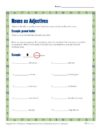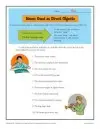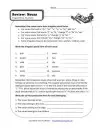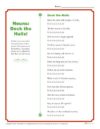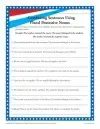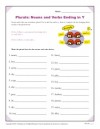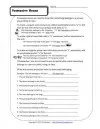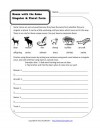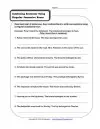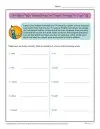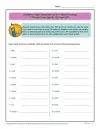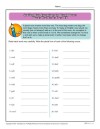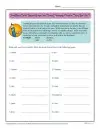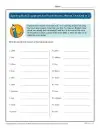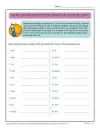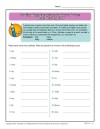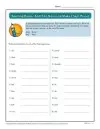Adjectives describe, or modify, nouns. Sometimes nouns can also modify other nouns. Let’s use ‘peanut butter’ as an example: ‘peanut’ is a noun that describes the main noun ‘butter’. With this worksheet, students will work through a series of questions that ask them to find the describing noun!
Nouns as Direct Objects Worksheet
Underline the verb that shows the action, and circle the direct object that receives the action.
Nouns as Indirect Objects
Underline the verb that shows the action, circle the direct object that receives the action.
Nouns Review 2
Write the irregular plural form of each noun. Write the correct possessive form for each belonging.
Nouns that are Also Verbs Worksheet
Depending on how they are used in a sentence, some words can either be a noun or a verb. For example, you can use the word, cook, as both a noun and verb. He will cook dinner tonight. The cook walked into the kitchen. With this printable activity, students will be given five words and will be asked to write each word once in noun form and once as a verb.
Nouns: Deck the Halls!
Circle the nouns in this classic Christmas carol. Remember, some nouns act as adjectives, but they are still nouns. This worksheet is a great way to keep students engaged and having fun as they learn about nouns.
Plural Possessive Nouns
Combine the two sentences. Write one sentence using a plural possessive noun.
Plurals: Nouns and Verbs Ending in Y
A spelling patterns worksheet about nouns and verbs that end in Y. Great for spelling skill development.
Possessive Nouns
Write the correct possessive noun to show each belonging.
Predicate Adjectives or Not?
Practice identifying predicate adjectives with this Parts of Speech Activity. A predicate adjective is an adjective that follows a linking verb and describes the subject of a sentence. In this printable worksheet, students will determine if the underlined adjective in the sentence is a predicate adjective or not.
Same Singular and Plural Nouns
Write one sentence using each noun as a singular noun, and one as plural.
Singular Possessive Nouns
Combine the two sentences. Write one sentence using a singular possessive noun.
Spelling Rule Exceptions for Plural Nouns: No S at All!
To make an English noun plural, add the correct suffix to the end of the noun. In this worksheet students will focus on words that require no s at all to become plural, then make each of the given words plural. For example, the word “child” becomes “children.”
Spelling Rule Exceptions for Plural Nouns: Words That End in CH and SH
In this worksheet, students will read carefully and make each word plural. Use this activity to teach your students how to properly use common prefixes and suffixes.
Spelling Rule Exceptions for Plural Nouns: Words That End in F and EF
To make an English noun plural, we usually add an s to the end of the noun. An exception to this rule is when a word ends in f or fe. This worksheet will help students learn how to properly make such words plural.
Spelling Rule Exceptions for Plural Nouns: Words That End in O
In this worksheet, students will read carefully and make each word plural. Use this activity to teach your students how to properly use common prefixes and suffixes.
Spelling Rule Exceptions for Plural Nouns: Words That End in S
A plural noun means more than one. Use this worksheet to help students learn how to make a noun plural by adding -es.
Spelling Rule Exceptions for Plural Nouns: Words That End in X and Z
To make an English noun plural, add the correct suffix to the end of the noun. In this worksheet, students will focus on words that end in x and z, then make each of the given words plural.
Spelling Rule Exceptions for Plural Nouns: Words That End in Y
To make an English noun plural, we usually add an s to the end of the noun. An exception to this rule is when a word ends in y. This worksheet will help students learn how to properly make such words plural.
Spelling Rules: Add S to Nouns to Make Them Plural
To make an English noun plural, we usually (but not always!) add an s to the end of the noun. In this worksheet, students will make each of the given words plural.
